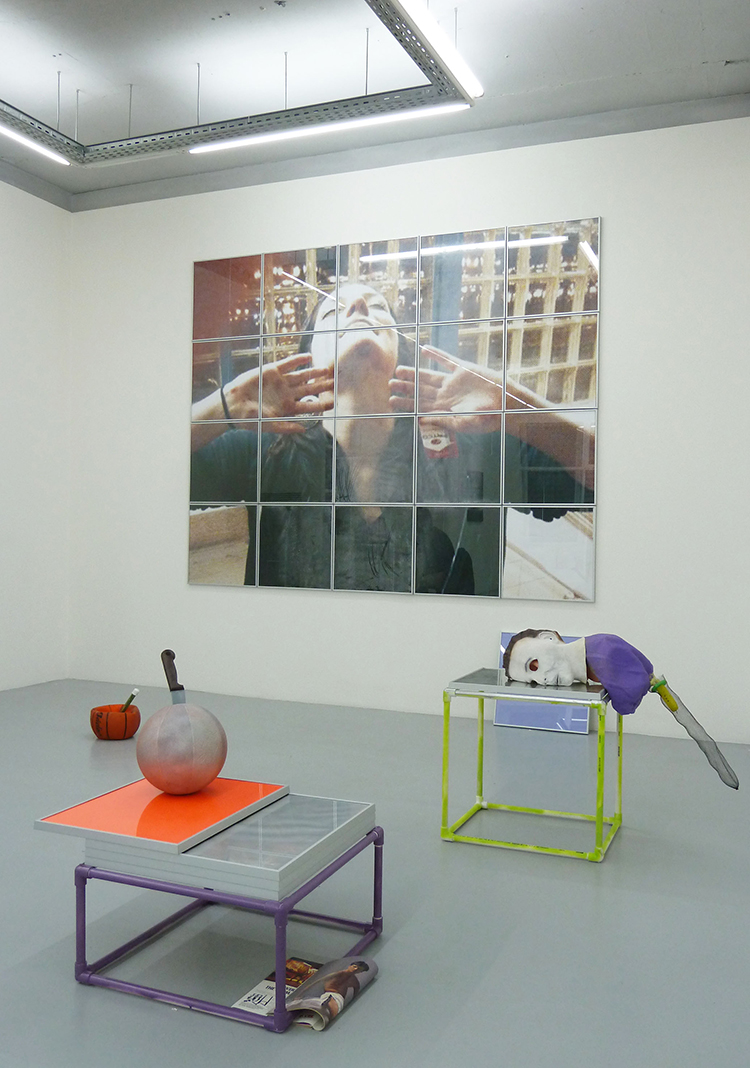
MARIE MAERTENS
( journalist, art critic, independent curator )
_______________________________________________________________
Alex Da Corte
_______________________________________________________________

Marie Maertens: You were born in Philadelphia, where you live now, and you have studied at Yale, in Connecticut. Yet, your work, and especially in your exhibition at Galerie Olivier Robert, seems to be close to a kind of Californian aesthetic I think particularly about Paul McCarthy. Could you explain why?
Alex Da Corte: I have always loved the grunginess and color sensibilities of Paul McCarthy and Mike Kelley. There has been a line drawn between my aesthetic and a Californian style before, but I grew up on the east coast and have only experienced that world through film and music. I think it would be more appropriate to compare my aesthetic to early Disney cartoons, Argento films, or Mary Shelly’s Frankenstein. The work stems from collecting and collaging disparate parts together- parts of memories, parts of dreams, parts of cultural excess to create for pleasure, humor or sadness sake.
The Shape, this strange and maybe dangerous character, seen in your pictures, makes me think about Patrick Bateman, the hero of American Psycho... Your atmosphere could entirely refer to Bret Easton Ellis, with this mix of glamour, beauty, fun and finally pathos. Do you agree?
I enjoy that comparison quite a bit. It seems as though you have a great fascination with ideas about Hollywood and the image makers of the West Coast. I feel as though my work is largely about surface and the skins of reality, how they conceal and what exists beneath. The memories that congeal to form this work propose false realities, fiction that I may or may not have lived through. Regardless, they are fictions I have absorbed and live in the face of. The work aims to confront our perception of things and propose ideas of newness and security in the unknown.
Don’t you think, and you already spoke a little bit about that in a former interview, that underground culture has become fashionable today and that we can ask ourselves what is it goal now?
When has underground culture been out of fashion? The problem of critiquing the center from the edge occurs when the edge inevitably moves towards the center and the conversation is compromised. The key is to continue to question the center regardless of where the work stands, by looking inward and disregarding the fashionable.
One of your work is an American flag. Did you want to pay homage to Jasper Johns? Some of your works seem to refer to the tradition of minimalism in US, is it important for you?
I was thinking of ideas about language and symbolism largely present in the US in the fifties and sixties in relationship to romance and the music of the Supremes, Otis Redding and early Etta James. The language used during this moment of music making has morphed over time, leading to new perspectives on symbols and standards prevalent in American culture at that time. Referring to traditions of minimalism from this distance seems futile. It is not my attempt to riff but rather investigate similarities in that cultural behavior and question why it continues to exist. This work is not proposing to answer anything, but rather attempt to make sense/non sense of that cultural residue by exposing holes and gaps in the Truths we lean on.
In the sculpture Accessory, you made, very meticulously, a snake with acrylic fingernails. It also reminds me the work of Amy Sarkisian, who was inspired by the gothic atmosphere, very present in LA where she lives, combined with a kind of “savoir-faire”, very precious. It’s not a new start in you work, but is it something you would like to develop?
There is winter work and summer work, in terms of my process and the pace, mood and colors in which I inhabit during those periods. One way of working cannot exist without the other for me. The way in which I arrive at this work is organic and constantly in conversation with my environment. It will continue to develop this way, in moments of meticulous collage or ecstatic and aggressive dancing, until I move to a place where the sun never sets and things stay relatively constant.
As you wrote before, are you really inspired by Janet Jackson videos’ ?...
Yes. The structure and color and composition of her videos and choreography have always been beautiful to me. Nobody can touch her style.
Interview realized January the 21st.
Alex Da Corte (b. 1981), lives and works in Philadelphia, PA.
Alex Da Corte – Night Chat, galerie Olivier Robert, until February the 24th.